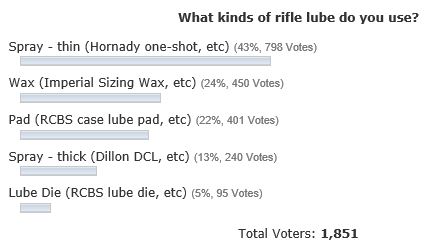May 21st, 2008
Regular readers of the Daily Bulletin know we’ve recommended Ballistol as a near-ideal case lube for basic full-length sizing. It’s extremely slick, and goes on very thin when applied with the aerosol version. Unlike many other case lubes, you won’t need to use a solvent or tumble the brass afterwards to remove. All you need is a very thin layer of Ballistol, and this easily wipes off with a paper towel. (For case-forming and neck expansion, we recommend a thicker lube such as Imperial Die Wax or Mobil 1.)

Unfortunately, many folks have told us that they can’t find Ballistol at local shops, or they want to combine it with a reloading supply order to cut down on shipping costs. Here are sources for Ballistol, including Brownell’s and MidwayUSA. For convenience, we recommend the aerosol version, but the liquid version can be diluted and used also.
Brownell’s
1.5 oz. Aerosol $4.43 982-000-001
6.0 oz. Aerosol $6.82 982-000-002
MidwayUSA
1.5 oz. Aerosol $3.99 727130
6.0 oz. Aerosol $6.49 831231
BULK ORDER SOURCES:
Ballistol USA
PACKAGE 1: BALLISTOL-LUBE
Two – 1.5oz. aerosols
Three – 6 oz. aerosols
$ 24.00 + 9.00 s&h = $ 33.00
FireHawktech.com
Basic Aerosol Pack
Two – 1.5 oz. Aerosol Can
One – 6 oz. Aerosol Can
Total $20.95 incl. shipping
Aerosol 5-pak
One – 1.5 oz. Aerosol Can
Four – 6 oz. Aerosol Can
Total $39.95 incl. Shipping
Ballistol Frequently Asked Questions
Q: Is the “Ballistol Lube” with the white label the same as the Ballistol “Sportsman’s Oil” with the green label.
A: Yes. Same product, just different labels. But remember there are both aerosol and liquid versions. The aerosol comes out very thin — like water. The liquid is thick — like motor oil.

Q: The liquid version is more economical by weight, but can I dilute it down?
A: Yes, Ballistol liquid can be diluted with water, up to a 10:1 ratio and it will remain slick. We recommend about a 6:1 ratio for use as a general case cleaner and lubricant — but you should experiment yourself.
Q: Will Ballistol get gummy over time, like other lubricants?
A: Nope. Here’s an interesting story. In 1952, a bottle with Ballistol, with the cap only loosely attached, was found in the attic of a deceased German hunter. The purchase receipt was found proving that the Ballistol had sitting for over 30 years. Yet, it still had the consistency of freshly produced Ballistol.
Q: If Ballistol oil can be diluted with water, does that mean it will promote corrosion?
A: No. Ballistol emulsifies in water. The resulting product will displace H20 like WD40, and then leaves a thin, protective oil. Ballistol is also mildly alkaline (pH between 8.5 and 9.5), so it neutralizes mild acidic residues such as hand sweat or residues from black powder (which are acidic).
Q: What’s Ballistol made from — it smells funny?
A: Ballistol is made from medical grade mineral oil, alkaline salts of oleic acid, several alcohols, Benzyl Acetate and oil from vegetable seeds. The smell comes from medicinal Anethole oil, which is derived from the Anise plant. Ballistol is biodegradable and non-toxic. CLICK HERE for the Material Data Safety Sheet
For more information on Ballistol, contact Ballistol USA, (800) 253 2460, (252) 261 0408 (fax).
 Versatile and Bio-Degradable
Versatile and Bio-Degradable














 Synthetic Motor Oil for Special Tasks
Synthetic Motor Oil for Special Tasks If you’re using a body die or a full-length sizing die, try using Ballistol (in the aerosol can) as a lube. It works GREAT without the tacky or gooey residue left by most case lubes. It will also clean off carbon residues on the neck as you lube the case. Just spray a little on a cotton patch (or your fingertips) and wipe each case before you run it up into the die. If you are using a steel neck bushing, be sure to wipe the neck as well. You can usually do a 6-10 BR-sized cases before you need to re-apply Ballistol on the patch. Ballistol is non-toxic, non-petroleum based, and will not harm your skin. It is very slippery, but can easily be removed with a rag or paper towel. Try it–you may retire your One-Shot. Derived from Pine Oil, Ballistol can also be used to protect wood stocks.
If you’re using a body die or a full-length sizing die, try using Ballistol (in the aerosol can) as a lube. It works GREAT without the tacky or gooey residue left by most case lubes. It will also clean off carbon residues on the neck as you lube the case. Just spray a little on a cotton patch (or your fingertips) and wipe each case before you run it up into the die. If you are using a steel neck bushing, be sure to wipe the neck as well. You can usually do a 6-10 BR-sized cases before you need to re-apply Ballistol on the patch. Ballistol is non-toxic, non-petroleum based, and will not harm your skin. It is very slippery, but can easily be removed with a rag or paper towel. Try it–you may retire your One-Shot. Derived from Pine Oil, Ballistol can also be used to protect wood stocks. Neck-Turning Lubes
Neck-Turning Lubes






